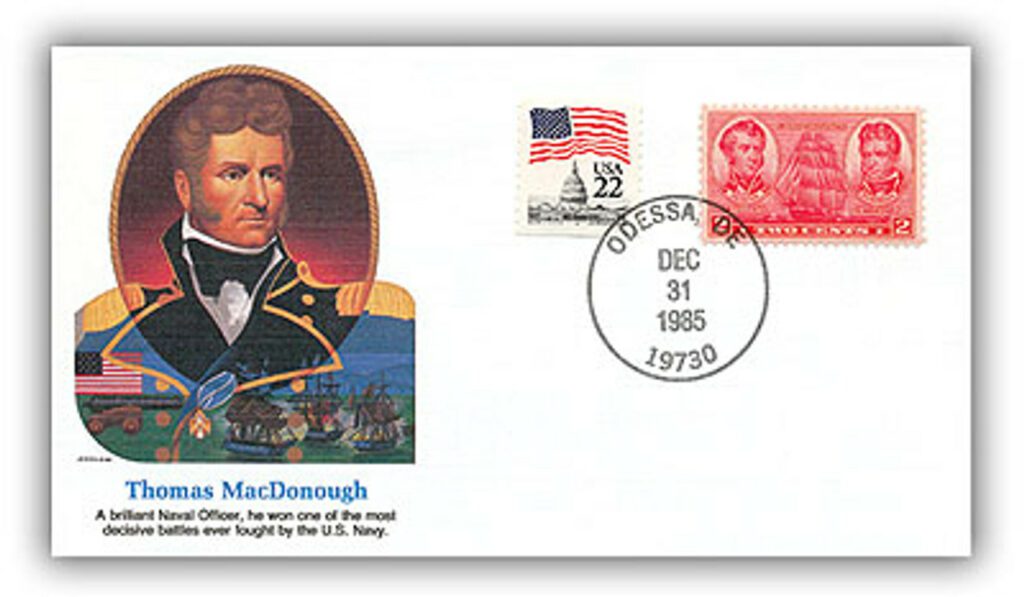On September 11, 1814, American forces won an important victory at the Battle of Plattsburgh (also known as the Battle of Lake Champlain).
By September 1814, peace talks were being held in the Netherlands in the hopes of bringing an end to the War of 1812. Yet at the same time, the British were forging plans to push into American territory.
Britain’s secretary of State for war and the colonies ordered George Prévost, commander in chief in Canada, to launch an offensive into American territory. But he also warned him to not travel so far that he would risk being cut off from supply lines. Prévost decided to launch his attack on Lake Champlain. The land attack would be on the nearest large American position at Plattsburgh, New York.
The majority of American troops at Plattsburgh were removed in late August to reinforce Sackett’s Harbor, leaving the fort defended by only about 1,500 men, most of whom were recruits or injured. Eventually, about 2,000 New York and Vermont militiamen arrived to help defend Plattsburgh, though they were largely untrained.
The British began marching to Plattsburgh on August 31. The American commander at Plattsburgh, Alexander Macomb, sent out over 1,000 troops for a delaying action, but they were slowly pushed back to the fort. Though the Americans burnt bridges and mislabeled signs along the way, the British reached Plattsburgh on September 6.
The fighting began on September 7, but the Americans managed to fend off each British attack. They continued to skirmish for a couple of days before the naval battle began on September 11. During those few days, American naval commander Thomas Macdonough set up his ships in Plattsburgh Bay, which would force the British to fight them at close range, so they would be more evenly matched.
The naval battle began at about 9 am on September 11. The British navy’s newly built Confiance was badly damaged early on and its commander was killed early in the fighting. Both sides suffered significant damage in the ensuing fight. This included Macdonough’s flagship, the USS Saratoga. Nearly all of the Saratoga’s starboard-side guns were taken out of action, but Macdonough turned the ship so he could use the guns from the other side.
Macdonough rained fire on the Confiance, and eventually, the vessel’s last surviving lieutenant had no choice but to surrender. When the British commanders boarded the Saratoga to surrender, they offered their swords to Macdonough, but he replied, “Gentlemen, return your swords to your scabbards, you are worthy of them.”

The land battle had still been going on during the naval engagement. But when Prévost received word of the loss, he realized that without control of the lake, he couldn’t resupply his men if they managed to take Plattsburgh, so he ordered a retreat.
In the end, the American forces, which were outnumbered on land and sea, earned an important victory. This success, as well as the American defense of Baltimore the following day, took away the leverage that the British negotiators wanted to try to claim territory at the end of the war.
| FREE printable This Day in History album pages Download a PDF of today’s article. Get a binder or other supplies to create your This Day in History album. |
Discover what else happened on This Day in History.



I wish I could leave a “10” response for this article. I had no knowledge about this piece of history. I vaguely remember learning about the War of 1812, but nothing more. Now I will certainly do more research into it. Very rewarding piece of history.
Excellent article. The British were trying to leverageNew England and upstate New York. The American fleet was smaller and had much shorter range on it’s guns, but MacDonough strategically took Ada vantage of the wind and tactics to defeat the superior British fleet.
Sitting on my porch here on the shore of Lake Champlain and gazing at the impressive monument erected in honor of Thomas Macdonough, I ask myself why the Postal Service chose not to include the Battle of Plattsburgh as part of the War of 1812 commemorative set. British failure to secure control of Lake Champlain was the decisive reason that drove their decision at Ghent to settle the war. The events at Fort McHenry had nothing to do with that decision because they had already humiliated the Americans by burning their capital city, and the Battle of New Orleans had not yet occurred.
Based upon the events at Plattsburgh, the American peace delegation, led by John Quincy Adams and their British counterparts both mutually agreed that the war was stalemated and elected to terminate hostilities on the principle of “status quo ante bellum.” It passes my
understanding why that proven fact is not given proper recognition today.